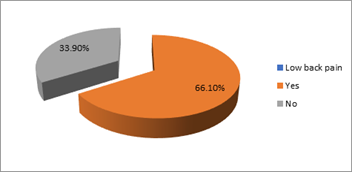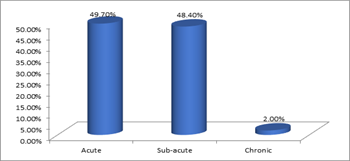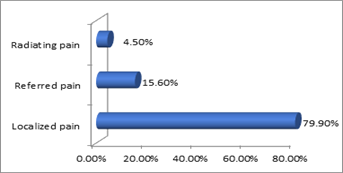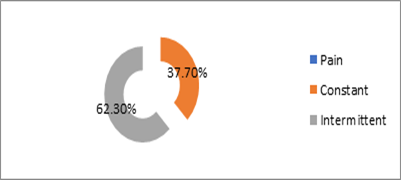Research Article
Low Back Pain Among Ethnic Pregnant Women
1Chief Consultant (Physiotherapy), Dinajpur Paralysis O Protibondhider Punorbason Kandro Hospital, Bangladesh.
2Assistant Professor, Department of Public Health, Fareast International University, Bangladesh.
*Corresponding Author: Md Monoarul Haque, Assistant Professor, Department of Public Health, Fareast International University, Bangladesh.
Citation: Islam S, Haque M. (2024). Low Back Pain Among Ethnic Pregnant Women, Journal of Clinical Medicine and Practice, BioRes Scientia Publishers. 1(1):1-6. DOI: 10.59657/jcmp.brs.24.001
Copyright: © 2024 Monoarul Haque, this is an open-access article distributed under the terms of the Creative Commons Attribution License, which permits unrestricted use, distribution, and reproduction in any medium, provided the original author and source are credited.
Received: February 05, 2024 | Accepted: February 21, 2024 | Published: February 28, 2024
Abstract
A cross sectional study was conducted to identify the state of low back pain and associated factors among ethnic pregnant women in Bangladesh. Considering time period and resource availability, cross-sectional analytical study design was most feasible for this study. The subjects were selected conveniently and conducted among 230 pregnant women residing in Rangamati hilly district. Face to face interview was carried out. Low back pain status was determined by taking history and conducting physical examination. Medical records were checked if available. Majority of the respondents (31.7%) completed HSC followed by graduation 22.6%, primary 21.3%, SSC 13.0% and post-graduate 1.7% and most of them were housewives. Prevalence of low back pain was 66.10%. Acute and sub-acute pain was nearly equal distribution i.e 49.70% and 48.40%. Localized low back pain was widely prevalent (79.90%) followed by referred pain (15.60%) and radiating pain (4.50%). Statistical strong significant association was found between trimester and low back pain. Wide prevalence of low back pain was seen among pregnant ethnic women which was acute and sub-acute in nature as well as localized.
Keywords: low back pain; low back pain; ethnic pregnant women; bangladesh
Introduction
Pregnancy related low back pain is a common complaint among pregnant women. It can potentially have a negative impact on their quality of life. The majority of women are affected in their first pregnancy.1 Eighty percent of women suffering from LBP claim that it affects their daily routine and 10% of them report that they are unable to work.2 Twenty percent of pregnant women will experience PGP. Pregnancy related LBP usually begins between the 20th and the 28th week of gestation, however it may have an earlier onset. The duration varies. A study about PGP in Netherlands shows that 38% of women still have symptoms at 3 months postpartum and 13.8% at 12 months.3 LBP during pregnancy is considered to be the most important risk factor for postpartum LBP and the existing literature supports LBP as the leading reason for sick leave, as far as pregnant working women are concerned.4 Bangladesh has a number of ethnic minor group population and they lead their life in great ethnic diverse fashion. They constitute about 1% of total population. They are distributed in scattered way all over the hilly, riverine and dense forest region of the country. Ethnic people are distinct from Bengali people by their ethnic origin, culture, feeding practice, literacy rate and profession. Locally, there is no literature on pregnancy and low back pain (LBP) among ethnic pregnant women.
Methods
Study design: Cross-sectional analytical study design.
Study Period: January to June, 2023.
Study place: This study was conducted in Rangamati hilly district.
Study population: Ethnic pregnant women live in Rangamati sadar upazila of Chittagong Hill Tracts.
Sampling technique: Non-probability convenient sampling was used to collect study subjects.
Data processing and analysis: After administering questionnaire, data were checked for consistency. Individual sheet was checked and cleaned to avoid any error. Data were categorized and coded during entry into the SPSS software. Collected data were analyzed by computer technology SPSS version 22.0. Collected information was presented in the form of tables and graphs. Descriptive statistics (mean, SD, frequency, percentage) and inferential statistics (Chi-square) were used.
Limitations of the Study: During the course of my study, I had to face some limitations. As I had to depend on the verbal response of the respondents, there might have been some discrepancy on their income level. There might have a bit of inaccuracy in collected information because I had to depend on their history and physical examination. Radiological and pathological examination were absent in some cases.
Results
This analytical study was conducted in Rangamati sadar upazila in order to determine pattern of low back pain and associated factors among ethnic pregnant women in Bangladesh. A semi-structured questionnaire was used to collect the information. A total of 230 ethnic pregnant women were interviewed to collect the data. All the data were entered and analyzed by using statistical packages for social science (SPSS) software version 22.0.
Table 1: Age group of the study subjects
| Age in year | Frequency | Percentage |
| 19-29 | 188 | 81.7 |
| 30-39 | 42 | 18.3 |
| Total | 230 | 100.0 |
| Mean±SD | 26.21±4.73 | |
Table 1 reveals that average age of the respondents was 26.21±4.73 years. Majority of the subjects (81.7%) belonged to 19-29 years and 18.3 percentage belonged to 30-39 years.
Figure 1: Prevalence of low back pain
It is revealed that prevalence of low back pain was quite double (66.10%) than who did not have the sufferings (33.90%).
Figure 2: Nature of low back pain
Figure 2 reveals that acute and sub-acute pain was nearly equal distribution i.e 49.70% and 48.40%. Prevalence of chronic pain was 2%.
Figure 3: Magnitude of pain
Figure 3 shows that localized low back pain was widely prevalent (79.90%) followed by referred pain (15.60%) and radiating pain (4.50%).
Figure 4: Type of low back pain
Of the respondents, intermittent pain was quite double (62.30%) than constant pain (37.70%).
Table 2: Association between age group and low back pain
| Age group | Low back pain | Total | χ2 | p-value | |
| Yes | No | ||||
| 19-29 | 120(52.2) | 32(13.9) | 152(66.1) | 2.340 | 0.126 |
| 30-39 | 68(29.6) | 10(4.3) | 78(33.9) | ||
| Total | 188(81.7) | 42(18.3) | 230(100.0) | ||
No statistically significant association was found between age group and low back pain.
Table 3: Association between occupation and low back pain
| Occupation | Low back pain | Total | χ2 | p-value | |
| Yes | No | ||||
| Housewife | 88(38.3) | 41(17.8) | 129(56.1) | 4.699 | 0.195 |
| Service | 30(13.0) | 16(7.0) | 46(20.0) | ||
| Business | 30(13.0) | 14(6.1) | 44(19.1) | ||
| Others | 4(1.7) | 7(3.0) | 11(4.8) | ||
| Total | 185(80.4) | 45(19.6) | 230(100.0) | ||
No statistically significant association was found between occupation and low back pain.
Table 4: Association between monthly family income and low back pain
| Family income | Low back pain | Total | χ2 | p-value | |
| Yes | No | ||||
| Low income | 9(3.9) | 2(0.9) | 11(4.8) | 2.203 | 0.332 |
| Middle income | 103(44.8) | 50(21.7) | 153(66.5) | ||
| High income | 40(17.4) | 26(11.3) | 66(28.7) | ||
| Total | 152(66.1) | 78(33.9) | 230(100.0) | ||
No statistically significant association was found between monthly family income and low back pain.
Table 5: Association between trimester and low back pain
| Trimester | Low back pain | Total | χ2 | p-value | |
| Yes | No | ||||
| First | 28(12.2) | 38(16.5) | 66(28.7) | 30.504 | 0.000 |
| Second | 50(21.7) | 27(11.7) | 77(33.5) | ||
| Third | 74(32.2) | 13(5.7) | 87(37.8) | ||
| Total | 152(66.1) | 78(33.9) | 230(100.0) | ||
Statistical strong significant association was found between trimester and low back pain.
Discussion
The present study reveals that average age of the respondents was 26.21±4.73 years. Majority of the subjects (81.7%) belonged to 19-29 years and 18.3
Conclusion
The study concludes that most of the ethnic pregnant women suffer from low back pain. Acute and sub-acute pain among the pregnant women was nearly equal distribution. But prevalence of chronic pain very insignificant among them. The study revealed that localized low back pain was widely prevalent followed by referred pain and radiating pain. Of the respondents, intermittent pain was quite double than constant pain. No statistically significant association was found between monthly family income and low back pain. In the study statistical strong significant association was found between trimester and low back pain. It is shown in the study that localized low back pain was widely prevalent followed by referred pain and radiating pain.
References
- Jeniffer S, Jonathan NG. (2008). Pregnancy and low back pain. Curr Rev Musculoskeletal Med, 1:137-141.
Publisher | Google Scholor - Wang SM, Dezinno P, Maranets I, Berman MR, Caldwell-Andrews AA, et al. (2004). Low back pain during pregnancy: prevalence, risk factors, and outcomes. Obstet Gynecol, 104:65-70.
Publisher | Google Scholor - Mens JM, Vleeming A, Stoeckart R, Stam HJ, Snijders CJ. Understanding peripartum pelvic pain. Implications of a patient survey. 21:1363-1369.
Publisher | Google Scholor - Van De Pol G, Van Brummen HJ, Bruinse HW, Heintz AP, Van Der Vaart CH. (2007). Pregnancy-related pelvic girdle pain in the Netherlands. Acta Obstet Gynecol Scand, 86:416–422.
Publisher | Google Scholor - Pierce H, et al. (2014). Pregnancy-related lumbopelvic pain: listening to Australian women. Nursing Research and Practice, 387428:1-10.
Publisher | Google Scholor - Bergström C, Persson M, Mogren I. (2014) Pregnancyrelated low back pain and pelvic girdle pain approximately 14 months after pregnancy–pain status, self-rated health and family situation. BMC Pregnancy Childbirth, 14(1):48.
Publisher | Google Scholor - Persson M, Winkvist A, Dahlgren L, Mogren I. (2013).
Publisher | Google Scholor - Schröder G, Kundt G, Otte M, Wendig D, Schober HC. (2016). Impact of pregnancy on back pain and body posture in women. J Phys Ther Sci. 28(4):1199-1207.
Publisher | Google Scholor - Branco MR. (2014). Santos-Rocha, Vieira F. Biomechanics of gait during pregnancy. The Scientific World Journal. 1-5.
Publisher | Google Scholor - Fitzgerald CM. (2013). Pregnancy-related lumbopelvic pain: what have we learned? Am J Obstet Gynecol, 208(4):242.
Publisher | Google Scholor - Elden H, Lundgren I, Robertson E. (2013). Life’s pregnant pause of pain: pregnant women’s experiences of pelvic girdle pain related to daily life: a Swedish interview study. Sexual Reproductive Healthcare. 4(1):29-34.
Publisher | Google Scholor - Close C, Sinclair M, Liddle D, Mc Cullough J, Hughes C. (2016). Women's experience of low back and/ or pelvic pain (LBPP) during pregnancy. Midwifery. 37:1-8.
Publisher | Google Scholor - Verstraete EH, Vanderstraeten G, Parewijck W. (2013). Pelvic Girdle Pain during or after Pregnancy: a review of recent evidence and a clinical care path proposal. Facts Views Vis ObGyn. 5(1):33.
Publisher | Google Scholor - Mahishale AV, Borkar SSS. (2015). Prevalence of Patterns of Pregnancy induced Pelvic Girdle Pain and Low Back Pain in a Tertiary Care Centre-a Cross Sectional Study. IJTRR. 4(4):122-124.
Publisher | Google Scholor - Ansari NN, Hasson S, Naghdi S, Keyhani S, Jalaie S. (2010). Low back pain during pregnancy in Iranian women: Prevalence and risk factors. Spine Journal. 26(1):40-48.
Publisher | Google Scholor - Meyer LC, Peacock JL, Bland JM, Anderson HR. (1994). Symptoms and health problems in pregnancy: their association with social factors, smoking, alcohol, caffeine and attitude to pregnancy. Pediatric and Prenatal Epidemiology. 8:145-155.
Publisher | Google Scholor - Ostgaard HC. Andersson GB, Karlsson K. (1991) Prevalence of back pain in pregnancy. Pubmed. 16(5):549-555.
Publisher | Google Scholor - Sabino J. Grauer JN. (2008) Pregnancy and low back pain. Current Review of Musculoskeletal Medicine. 1:137-140.
Publisher | Google Scholor - Mogren IM, Pohjanen AI. (2002). Low back pain and pelvic pain during pregnancy: prevalence and risk factors. Obstetrics and Gynecology. Department of Clinical Science, Umea University, Sweden.
Publisher | Google Scholor - Wang SM, Dezinno P, Maranets I, Berman MR, Caldwell AA, Kain ZN. (2004). Low back pain during pregnancy: prevalence, risk factors, and outcomes. Obsterical Gynecology,104(1):65-68.
Publisher | Google Scholor - Mantle MJ, (1997). Greenwood R, Currey HLF. Prevelence of backache in pregnancy. Rheumatologic Rehabilitation. 16:95-99.
Publisher | Google Scholor - Stapleton DB, MacLennan AH, Kristiansson P. (2002). The Prevalence of Recalled Low Back Pain During and After Pregnancy: A South Australian Population Survey. Obsterical Gynaecology, 42(5):482-487
Publisher | Google Scholor - Joseph JF, Cragin L. (1998). Biomedical and Feminist perspectives on low back pain in pregnancy. Nursing clinics of North America, 33(4):713-714.
Publisher | Google Scholor - Ostgaard HC, (1991). Anderson GB, Wennergren M. The impact of low back and pelvic pain in Pregnancy on the pregnancy outcome. Acta Obstetricia et Gynecologica Scandinavica, 70(1):21-24.
Publisher | Google Scholor - Ingrid M, Anna M, Potjaman I. (2007). Low back pain and pelvic pain during pregnancy: prevalence and risk factors. Pain, 30(8):983-991.
Publisher | Google Scholor - Hills EC. (2010). Mechanical Low Back Pain. Medicine. 2(4):56-58.
Publisher | Google Scholor


















